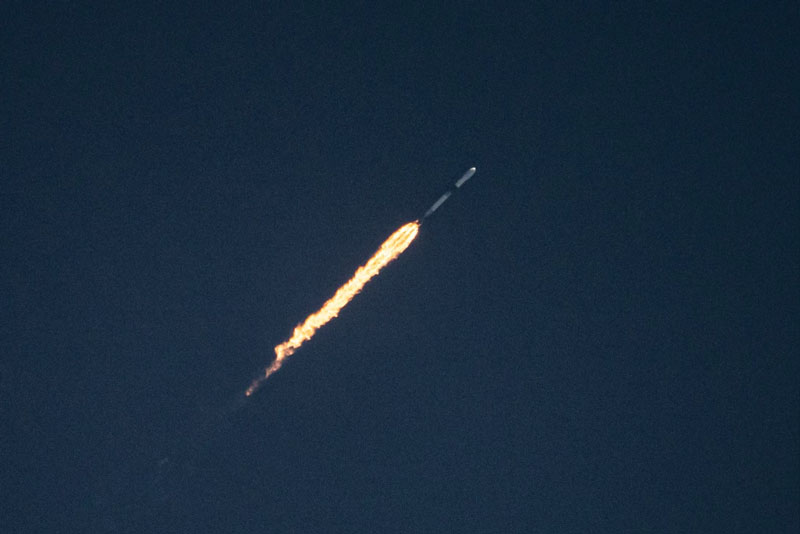 A Falcon 9 rocket carrying a pair of Galileo satellites for the European Commission’s constellation lifts off from Launch Complex 39A on April 27, 2024. The last time SpaceX launched an expandable Falcon 9 rocket was back in November 2022, 146 missions ago. Image: Adam Bernstein/Spaceflight Now
A Falcon 9 rocket carrying a pair of Galileo satellites for the European Commission’s constellation lifts off from Launch Complex 39A on April 27, 2024. The last time SpaceX launched an expandable Falcon 9 rocket was back in November 2022, 146 missions ago. Image: Adam Bernstein/Spaceflight Now
SpaceX hit some notable milestones with the launch of its Falcon 9 rocket from NASA’s Kennedy Space Center on Saturday. Most notably, the weekend flight marked the first time that the European Commission’s Galileo satellites (similar to the United State’s Global Positioning System (GPS) satellites) launched onboard an American-made rocket and from U.S. soil.
The Falcon 9 rocket lifted off from Launch Complex 39A (LC-39A) at 8:34 p.m. EDT (0034 UTC). The first stage booster on this mission, tail number B1060 in the SpaceX fleet, launched for a 20th and final time. SpaceX did not plan to recover B1060 “due to the additional performance requirement to deliver the payload to medium Earth orbit.”
“The last time a first stage was expended during a Falcon 9 mission was 146 flights ago in November 2022,” SpaceX said in a social media post following the launch. “On most Falcon 9 missions, enough propellant remains in the first stage after stage separation to enable landing, recovery, and ultimately reuse on future missions.”
SpaceX added that it is in the process of qualifying both its boosters and its payload fairings for up to 40 missions each. They credit the data gathered on Falcon vehicle flights to furthering their development of the significantly larger and entirely reusable Starship rocket and their stated goal of “making life multi-planetary.”
While B1060 was not being recovered on this flight, it marked the most flight proven booster to launch a customer payload. The previous record was held by the same booster when it launched Intuitive Machines’ Nova-C lunar lander on its 18th flight in February.
Because it wasn’t recovered, SpaceX removed the hypersonic grid fins normally affixed at the top of the booster as well as the four landing legs.
The two-part payload fairing protecting the two Galileo satellites were scooped up out of the Atlantic Ocean by the recovery vessel, Bob, named for former NASA astronaut, Bob Behnken of the Demo-2 mission. SpaceX noted that this was also the 200th mission that used flight-proven payload fairings.
This Falcon 9 first stage has launched ~200 spacecraft as part of our Rideshare program, supported 13 @Starlink missions to help connect people all around the world with high-speed, low-latency internet, sent a lunar lander to the Moon, and more. In total, this Falcon delivered… pic.twitter.com/IDul5eJIum
— SpaceX (@SpaceX) April 28, 2024
American solutions for European launch vacuum
The Galileo satellite constellation is part of Europe’s global navigation satellite system (GNSS). It’s similar to others operating around the world, the most prevalent of which is the United States’ Global Positioning System (GPS).
Galileo is been in operation since December 2016 and currently consists of 28 satellites, which orbit the Earth at 23,000 km. According to the European Union Agency for Space Programme’s (EUSPA) GNSS Service Centre (GSC), eight out of the 28 are listed as either “not usable” or “not available.”
The pair that launched on Saturday will support the current constellation and offer supplementary services in the event another satellite stops working as intended.
Historically, all of the satellites have launched on either Russian Soyuz rockets or the Ariane 5, but neither are an option any more. The European Space Agency (ESA) stopped using Soyuz as a launch vehicle following Russia’s invasion of Ukraine in February 2022 and the final Ariane 5 rocket launched in July 2023.
 According to the European Space Agency, “Galileo Second Generation will provide unprecedented precision, robustness and flexibility with new and improved services, fully compatible with Galileo First Generation and other satellite navigation systems for the best results.” Image: ESA
According to the European Space Agency, “Galileo Second Generation will provide unprecedented precision, robustness and flexibility with new and improved services, fully compatible with Galileo First Generation and other satellite navigation systems for the best results.” Image: ESA
During a press conference at the European Space Summit in Seville, Spain, in November 2023, Thierry Breton, the European Commission’s commissioner for the internal market, said that the continent’s lack of an orbital class rocket meant America, and SpaceX in particular, was their next logical option.
“We have four satellites to launch [in 2024] and given that Ariane 6 is still not going to be available, I accepted a proposal from ESA to use SpaceX,” Breton said. “We’re talking about very critical satellites. And so, we’re still negotiating with the American side and once that’s been finalized, yes, we will have two launches for four satellites, which will be carried out by SpaceX.”
Breton noted that the second launch via SpaceX is anticipated in July 2024.
According to a report in Politico, the European Commission cemented the €180 million (about $192.5 million), two-launch deal with SpaceX on March 19. That represents a roughly 36 percent markup on the cost of the two missions compared to the standard payment plan for a dedicated Falcon 9 launch, which is $67 million.
SpaceX notes in the “Capabilities and Services” section of its website that “Missions purchased in 2022, but flown beyond 2023 may be subject to additional adjustments due to inflation.”
 The Galileo Second Generation satellites will be launched in pairs, interconnected and connected to the launcher until separation. Each satellite is over 2000 kg and when stacked, they reach a towering height of seven meters. This configuration has undergone vibration tests at ESA’s Hydraulic Multi-axis Shaker (Hydra) and received mechanical qualification. Image: ESA
The Galileo Second Generation satellites will be launched in pairs, interconnected and connected to the launcher until separation. Each satellite is over 2000 kg and when stacked, they reach a towering height of seven meters. This configuration has undergone vibration tests at ESA’s Hydraulic Multi-axis Shaker (Hydra) and received mechanical qualification. Image: ESA
This is not the first time that the lack of a European orbital launch vehicle has caused them to lean on SpaceX. In July 2023, a Falcon 9 rocket launched Euclid, the wide-angle space telescope designed to study the so-called “dark universe.” SpaceX was also selected to launch the EarthCARE (Clouds, Aerosols and Radiation Explorer) spacecraft to a Sun-synchronous 400 km polar orbit in May and the Hera spacecraft to the asteroid, Didymos, in October.
A letter from Pietro Francesco de Lotto, the president of the Consultative Commission on Industrial Change, to the European Parliament opined on the growing gulf in space access for Europe compared to other global space powers. He argued that “the European space sector is facing an increasing number of threats.
“The funding gap with the US and China is widening. European space budgets are six times lower than those in the US, and the budgets available within the EU are mostly uncoordinated, while American space doctrine has made space a key instrument for its supremacy and independence in this domain,” he wrote. “China’s exponential rise cannot be ignored. Other actors such as Russia and India are also stepping up their game.
“Finally, the European space industry is now competing with giant players outside Europe, which have optimised their internal supply chains and are massively disrupting the markets (SpaceX in particular).”
 The Falcon 9 carrying Euclid climbs away from Florida’s Space Coast on July 1, 2023. Image: Michael Cain/Spaceflight Now.
The Falcon 9 carrying Euclid climbs away from Florida’s Space Coast on July 1, 2023. Image: Michael Cain/Spaceflight Now.
The impact of SpaceX is something that has been discussed by Europe for years. A 2007 report from the Commission of the European Communities talked in part about the prospective global space industry and noted that “The entry of low-cost launchers such as the Space Exploration Technology (SpaceX) Falcon may represent a major competitive threat for established launcher manufacturers, with pricing aimed at 70 percent less than them.”
The launch campaign of the first launch of the Ariane 6 rocket is now finally underway with a launch date targeting summer 2024 somewhere between June 15 and July 31.
“Getting Ariane 6 to launch and to re-establish Europe’s access to space is of highest priority for ESA to resume regular rocket launches from Europe’s Spaceport,” said ESA’s Director General, Josef Aschbacher in a statement. “Having the rocket stages together on the launch pad marks the start of a launch campaign and shows we are almost there: soon we will see this beauty soar to the skies.”
✅Upper stage firing test
✅Transfer and verticalisation of central core
✅Transfer of the boosters to the launch padNext up:
🔜Ariane 6 qualification review results expected in the beginning of May
🔜Payload arrival in Kourou, French Guiana@ESA, @CNES and @ArianeGroup are… https://t.co/mCpJ8kWfyj— Josef Aschbacher (@AschbacherJosef) April 26, 2024
Secrecy for launch
Unlike the recent launches of Galileo satellites, there is notably much more secrecy surrounding this mission. The SpaceX mission page doesn’t note that there are two satellites on board, rather just noting that this flight is called the “European Commission’s Galileo L12” mission.
The published launch timeline is also remarkably truncated. Public information shared prior to liftoff ends with the deployment of the Falcon 9’s payload fairings at T+3 min 39 sec into the mission.
That stands in stark contrast with the most recent Galileo mission using a Soyuz rocket on December 4, 2021, which featured a launch broadcast from Arianespace that lasted more than four hours. The broadcast notably stayed through payload deployment at an altitude of 23,544 km (about 15,000 miles).
Despite the importance of the Galileo satellite constellation to ESA and the EC, neither agency has mentioned the pending launch in the past week leading up to liftoff.
>>> Read full article>>>
Copyright for syndicated content belongs to the linked Source : Spaceflight Now – https://spaceflightnow.com/2024/04/27/live-coverage-spacex-to-launch-european-commissions-galileo-satellites-on-falcon-9-rocket-from-the-kennedy-space-center/













![[News] Japan Develops 10nm Nanoimprint Technology, with Potential to Tackle EUV Bottleneck – TrendForce](https://earth-news.info/wp-content/uploads/2025/12/329851-news-japan-develops-10nm-nanoimprint-technology-with-potential-to-tackle-euv-bottleneck-trendforce-360x180.jpg)














![[News] Japan Develops 10nm Nanoimprint Technology, with Potential to Tackle EUV Bottleneck – TrendForce](https://earth-news.info/wp-content/uploads/2025/12/329851-news-japan-develops-10nm-nanoimprint-technology-with-potential-to-tackle-euv-bottleneck-trendforce-120x86.jpg)

